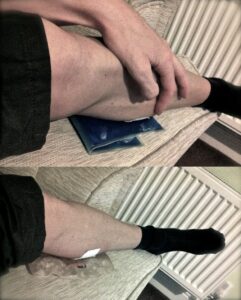Calf strains while running are a common and often debilitating injury that many runners encounter at some point in their training journey. These injuries primarily affect the calf muscles, which play a crucial role in the mechanics of running. Understanding the intricacies of calf strains is essential for both preventing and effectively managing this prevalent issue among athletes.
Anatomy of the Calf Muscles
To comprehend calf strains while running, it’s imperative to delve into the anatomy of the calf muscles. The calf is comprised of two main muscles: the gastrocnemius and the soleus. The gastrocnemius, with its medial and lateral heads, is the more superficial of the two, while the soleus lies deeper within the leg. These muscles converge to form the Achilles tendon, connecting the calf to the heel.

Types of Calf Muscle Injuries
Calf injuries encompass a range of issues, from minor strains to more severe calf muscle tears. Calf muscle strain is a form of muscular injury that occurs when the calf muscles are stretched beyond their normal capacity, leading to tears in the muscle fibers. This can result in varying degrees of pain and limited mobility.
Common Symptoms and Indicators
Identifying a calf strain while running involves recognizing key symptoms. Sudden, sharp pain in the calf during a run is a telltale sign. This pain may be accompanied by tenderness and swelling in the affected area. In more severe cases, runners may experience difficulty in performing tasks that require ankle plantar flexion, such as walking or running.
Risk Factors for Calf Strains in Runners
Several factors can increase the likelihood of experiencing calf strains while running. Improper running technique, overexertion, and inadequate warm-up routines are common culprits. Additionally, runners who engage in high-speed tempo runs or neglect cross training may be more susceptible to calf muscle injuries.

Prevention and Rehabilitation
Preventing calf strains requires a multi-faceted approach. This includes incorporating progressive calf training, regular stretching, and ensuring adequate rest and recovery. Strengthening exercises, such as single-leg calf raises, can help fortify the calf muscles and reduce the risk of muscular calf injuries.
In the event of a calf strain, early intervention is crucial. Rest, ice, compression, and elevation (RICE) can help alleviate immediate pain and swelling. Physical therapy, focusing on resisted muscle testing and targeted stretches, aids in the recovery process. It’s also important to gradually reintegrate running activities to avoid exacerbating the injury.
Recurrent Calf Strains and Underlying Issues
For some individuals, recurrent calf strains may be indicative of deeper underlying problems. Issues like tight proximal Achilles fascia or weaknesses in other muscle groups can contribute to a cycle of recurring injuries. Identifying and addressing these issues with the guidance of a sports medicine professional is paramount to long-term recovery and calf injury prevention.
Final Thoughts – Calf Strains While Running
Calf strains while running are a common, yet often preventable, affliction among athletes. Understanding the anatomy of the calf muscles, recognizing symptoms, and implementing preventative measures are crucial steps in reducing the risk of injury. With proper care and attention, runners can not only recover from calf strains, but also build stronger, more resilient muscles for a pain-free and enjoyable running experience. Remember, taking care of your body is essential for sustaining a long and fulfilling running journey.
